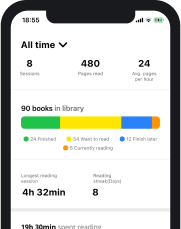Reading in the car while someone else is driving can be an extremely pleasurable activity. You’re taking full advantage of your commute time, whether you’re being driven to your workplace, on vacation, or anywhere else. You spend some quality time while traveling, so what could go wrong? Unfortunately, quite a lot.
For those of us with motion sickness, reading in the car can turn from an amazing experience to a dreadful one in just a matter of minutes. Being car-sick is not a fun experience by any means, but the big question is: are there any solutions?
Learning how to read in the car without getting sick can make a huge difference both in the quality of your travel time and also in your reading habits.
Is it bad to read in the car?
Generally speaking, reading is an extremely beneficial activity that we find very hard disadvantages for. Here at Basmo, we are dedicated to making people read as much and as effectively as possible, so finding flaws in the habit of reading is usually really hard for us.
One thing that is worth noting is that no research has been done particularly to explore the effects of reading in a moving car. Even though no scientist has published a paper on the dangers of reading while being driven somewhere, we gathered a lot of information from the Basmo users and from other avid readers to see exactly what their experience was.
That being said, reading in any situation is generally not dangerous or harmful. There are cases though when reading can cause some discomfort. For example, a person with motion sickness may experience quite severe symptoms if they do some reading while sitting in the back seat of a car on a winding road.
While reading in the car is far from being considered a health risk, it can lead to pretty unpleasant results if certain factors contribute to the situation in an unlucky combination.
Is reading in the car bad for your eyes?
Reading is usually not a dangerous activity by any means. As a matter of fact, it is perhaps the most recommended entertaining activity, one that can completely change the way you live your life and how you perceive the world you live in. On top of this, there are a lot of physical and mental health benefits associated with reading.
While reading can be relatively tiring and able to cause some mental fatigue, especially during long reading sessions, the impact it has on our eyes is minimal if we follow a couple of rules. Keeping our reading material at our eyeline would be the first thing we should worry about so that we don’t force our eyes to focus at an uncomfortable angle.
That being said, reading in the car is almost guaranteed to force your eyes to focus at all kinds of different angles. Regardless of how smooth the ride is and how comfortable the car is, you are still moving quite fast and the car is deemed to keep turning to follow the road. This is going to force your eyes to follow the book as it moves around.
Reading in the car can cause much more severe eye fatigue than regular reading, with a much quicker and more annoying onset. This fatigue or eye strain will have certain uncomfortable symptoms like dry eyes, foggy vision, dizziness, headaches, or itchy eyes.
The good news is that even if you do get to experience any of these symptoms, their effect is not going to be long-lasting. Regardless of how bad it gets in the moment, the reality is that you are always going to be just a couple of hours away from feeling like new.
Give Your Reading Experience
An Extra Boost With Basmo
Track the books you read, monitor the time you spend reading and keep notes on your reading habits and how it makes you feel. You can set yourself targets for the time you spend reading and you can get notified whenever you’re behind on your reading time.
Why does reading in the car cause sickness?
Eye strain is obviously the least of your concerns when it comes to reading in the car. What is a lot scarier is getting car sick. In case you are one of the lucky ones who don’t even know what the symptoms of getting car sick are, here’s a list of the most common ones:
- Dizziness
- Fatigue
- Cold sweats
- Headache
- Nausea and vomiting
- Increased salivation
- Pale skin
- Irritability
- Inability to focus
That doesn’t sound too fun, does it? In order to understand how reading plays a role in car sickness, it’s best to start by exploring what exactly causes this condition in the first place.
Being car sick is part of a bigger issue, which is motion sickness. Having motion sickness is a dreadful experience and can have a serious impact on the quality of life of those affected.
To keep it short, motion sickness is a phenomenon where your brain can’t really make any sense of the information it receives from the main receptors: eyes, ears, and the rest of the body. While the condition can affect anyone, it’s estimated that one in three people gets motion sickness at least once in their lifetime, but children between ages 2 and 12 and women are more likely to suffer from it.
Your eyes, inner ear, muscles, and joints are constantly sending signals to your brain in regards to the motion your body is going through. As long as the information received from the sensors is matched by all the other sensors, your brain understands exactly what is happening. If one of the sensors gives out information that isn’t matched by the other receptors, things change. For example, if your inner ear feels a movement that isn’t matched by the information your eyes are sending to the brain, motion sickness is likely to start settling in.
That is exactly what happens when you read in the car. While your body experiences motion, most of the motion sensors are sending out signals to your brain that translate the movements you are going through. The car is going left, your inner ear feels that you are going left, and the brain learns that you are going left. If you were to look out the car window and see how the scenery changes as you go to the left, your brain would receive confirmation that this is exactly what is happening.
If you are reading, your eyes will remain somewhat stuck in the position where they can focus on the book. That means that they won’t send a confirmation to the brain to validate the information it receives from the other sensors. This mismatch in the information received is what causes motion sickness, and as you can see, reading can have a huge impact.
The inconsistencies in the information received from sensors provoke a confusing response in the brain, which translates into the symptoms I mentioned above. The symptoms are more likely to appear and be more severe if the road you are being driven on is winding (like mountain roads), if the ride is particularly long, or if the driver is feeling particularly sporty that day.
How to read in the car without getting sick?
One thing that is worth mentioning when it comes to getting car sick because of reading is that nobody is actually immune to it. Even if you’ve never been sick in a car before and never experienced any motion sickness regardless of how bumpy the ride or flight was, you can still experience some pretty nasty symptoms if you’re reading in a moving car. Just to make things clear, looking at a laptop or at your smartphone is just as bad and just as likely to cause motion sickness.
Antihistamines
Even though they are usually used to treat allergies, antihistamines are particularly effective in preventing motion sickness symptoms. Take a pill before the ride and you might be able to have a good reading session regardless of how tough the ride is going to be. At least for a while. That’s because the only antihistamines that are effective in fighting motion sickness are the ones that also cause drowsiness, so you might get too tired to read at some point.
Motion sickness patches
While there are many other motion sickness remedies out there, scientists stand behind scopolamine as being the most effective. Whether you take a pill or choose the skin patches, scopolamine is very likely to efficiently allow you to travel without experiencing any annoying symptoms, even if you do some reading in the car. Patches are particularly effective and convenient because you simply have to stick one behind your ear and you can keep it there for up to three days, so it’s a pretty great solution for particularly long drives.
Eat some ginger
There are many natural remedies to avoiding motion sickness, but ginger is by far the most effective one. It’s been used for centuries, even by sailors who stand behind it as the best sea sickness remedy. Not only will eating ginger help you do some reading in the car regardless of how tough the drive is, but it is also very healthy and has quite a lot of other benefits for you.
Use Basmo
The most important thing to keep in mind when it comes to reading in a moving car is that the duration of your reading session can play a crucial part. While a couple of minutes of reading on a winding road can have no consequences, extended reading sessions are almost guaranteed to get you car sick.
What you should do is use a reading tracking app like Basmo to make sure you learn about the ideal duration of a reading session in a moving car and to ensure that you have a constant reminder to take breaks often.
Basmo has been designed to meet every possible need of a modern reader, and believe it or not, reading in a car happens a lot more often than you might think. That is why our app’s functionalities can easily be used to ensure the quality of your reading sessions regardless of the environment they take place in.
For example, every time you start a reading session, the app will start recording it: it times the session and gives you important information about your reading speed, and other relevant data.
You can use this to make sure your reading sessions are not overextended while in a car. If you know you can safely read for 15 minutes while you’re being driven on a winding road, you can use the timer within the app to make sure you stop at the right time before you start getting sick.
Take a break, look out the window, get a whiff of fresh air, and get back to it for another 15 minutes.
The app also allows you to keep a reading journal, take notes, and keep your emotions in check.
In case you are trying to figure out your limit for reading in the car, for example, if you’re reading on your daily commute, you can take notes within each reading session, and jot down for how long you managed to read without getting sick.
Not only that, but the app will also prompt you to select an emoji that matches your emotional status after each reading session is ended and provides you with a nice weekly report. This can also be extremely helpful in determining for how long it is safe for you to read while in a moving car.
Final thoughts on reading in the car
While reading in the car can be extremely enjoyable, you should know your limits. Use Basmo to establish for how long you are able to read in a moving car without getting sick and then to make sure you always remember to take breaks as often as needed.
Image by pch.vector on Freepik







